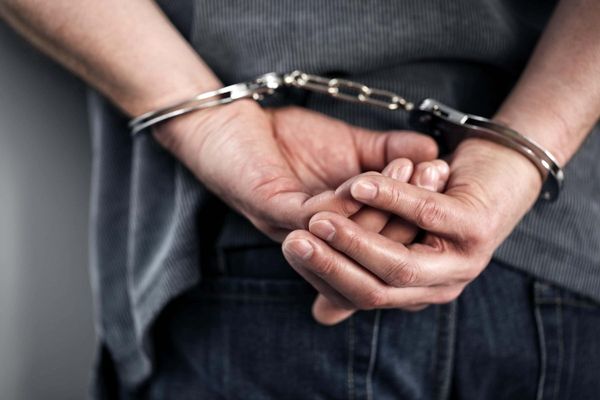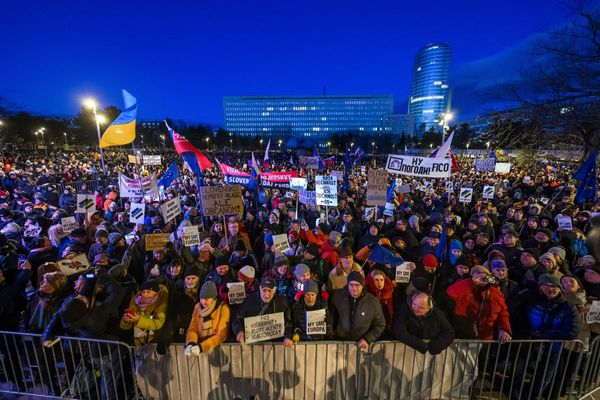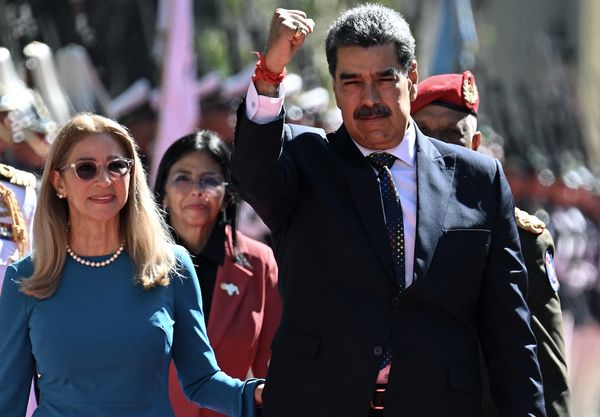
RAMALLAH, West Bank—As Israel pummeled Gaza with airstrikes for 11 days before a cease-fire went into effect on May 21, the Palestinian Authority (PA) was eerily absent from the scene, doing little beyond issuing pro forma statements of condemnation of the Israeli bombing campaign and the staggering death toll it caused.
But on the ground, civic leaders, especially Palestinian youth, have taken over the vacuum left by this rudderless leadership. Last week, they, together with Palestinian civil society groups, held a general strike throughout the occupied West Bank and Israel. The strike was significant in that it was strictly adhered to on both sides of the Green Line, essentially erasing—albeit temporarily—the pervasive geographical and political divide between Palestinians who are citizens of Israel and those who are not.
Before the current crisis, Palestinians’ frustration with their leadership had already reached unprecedented levels. The potential of Palestinian democracy has long been limited by Israel’s control of every facet of daily life in the occupied Palestinian territories, including of the electoral system. The last time a Palestinian legislative election was held, in 2006, Israel heavily obstructed voting in East Jerusalem. When Hamas then won a decisive victory, the United States and Israel destabilized the new government, installing PA President Mahmoud Abbas and his party, Fatah, into power in the West Bank.
In January, Abbas called for parliamentary and presidential elections to be held this spring and summer—but few were surprised when he ultimately indefinitely postponed them on April 29. Though Abbas blamed the decision on Israeli authorities’ refusal to allow voting in East Jerusalem, many believe he was in fact responding to a schism within Fatah, which threatened to complicate his reelection and weaken his iron grip on PA institutions.
The elections might have offered Palestinian voters the chance to put their support behind independent electoral lists. Though repressive legal restrictions prevented some groups—such as the Generation for Democratic Renewal, a youth-led political initiative—from running, polls showed growing support for a new list led by Nasser al-Qudwa, the late Palestinian leader Yasser Arafat’s nephew, which campaigned on a promise to fight rampant corruption, support the rule of law, and hold regular elections.
The election postponement contributed to growing disillusionment among Palestinians, who had registered to vote in large numbers despite polling showing deep skepticism that elections held under the current circumstances would be free and fair. Many Palestinians view the PA as preventing them from choosing representatives who speak to their needs and aspirations.
For young Palestinians in particular, fresh elections had presented a rare opportunity. Abbas is 85 years old and has been president since he was elected to what was supposed to be a four-year term in 2005. Many Palestinian youth born after the Oslo Accords were signed in 1993 have never cast a ballot. The United States has chosen to ignore this paradox, which sits in stark contrast to purported American values of human rights and democracy promotion.
“The canceling of the elections ramped up the frustration and anger,” said Nadia Hijab, co-founder and board president of Al-Shabaka: The Palestinian Policy Network. “Elections under occupation are not as meaningful because you really have no control whatsoever,” but losing the opportunity to vote was still disheartening, Hijab conceded.
Just before Abbas issued his decree, protests in Jerusalem began to draw international attention when Israeli authorities placed barriers at Damascus Gate, a meeting spot for mostly young Palestinians—especially during the Muslim holy month of Ramadan. The police claimed that sitting in the area has been forbidden for over a decade.
A short walk away, in the Sheikh Jarrah neighborhood, Palestinian families were protesting looming eviction from their homes by right-wing Israeli settler organizations. The demonstrations swelled after an Israeli lower court in Jerusalem ruled in favor of the settlers earlier this year. The Israeli Supreme Court announced May 9 that it would delay hearing an appeal for one month.
Against this backdrop, Israeli police entered the Al-Aqsa Mosque compound and assaulted worshippers during the holiest night of Ramadan, triggering further outrage and anger that reverberated across the rest of the occupied Palestinian territories and throughout Israel. Hamas-launched rockets began to rain down on Israel from the besieged Gaza Strip, only to be followed by intense aerial attacks by Israeli forces. The assaults killed 248 Palestinians and 12 Israelis.
Along with destruction and fear, the crises in Gaza and East Jerusalem have produced new levels of unity in a Palestinian polity that has long been fragmented. For more than a decade, the schism between the rival factions of Fatah, which administers the occupied West Bank, and Hamas, which controls Gaza, has left Palestinians geographically and politically divided.
East Jerusalem, which Israel captured in the 1967 war and has controlled since, has largely been left without political representation; Gaza is isolated under a blockade that began in 2007; and Palestinian citizens of Israel are caught between seeking representation from the traditional Arab parties and participating in an Israeli political system that refuses to see them as equals. In the last week, however, Palestinians have demonstrated as one—on both sides of the Green Line. They were united by Sheikh Jarrah, which has become a symbol of common struggle—one that has overcome traditional factional squabbles to translate into real action.
Without a political manifesto to which they must adhere, young Palestinians have taken to social media to raise awareness about the Israeli attacks on Gaza and the looming eviction of their fellow Palestinians in East Jerusalem.
Despite having been denied formal participation in Palestinian elections, and their oppression at the hands of Israeli—and sometimes Palestinian—security forces, these young Palestinians have been campaigning on the ground, setting up support groups in places like Sheikh Jarrah, attending Israeli court hearings, and making their voices heard through protests and by speaking to the media. These activists’ communal solidarity, which had no prior coordination, has managed to hurl the Palestinian cause back into the political mainstream.
“The people who claim to be leaders of the Palestinian people have failed to provide a national strategy,” said Rashid Khalidi, a historian and professor at Columbia University. “The Palestinian leadership is Palestinian civil society.”
The demonstrations have gathered particular force in Israeli-controlled East Jerusalem, where the PA has neither access nor the political authority to restrain them. For Palestinians here, the last 10 years have been marked by increasing marginalization by the state. Poverty and crime have risen sharply, bringing with them disaffection, drugs, and the rage heard in nihilistic hip-hop forged behind the separation wall in neighborhoods like Issawiya and Kufr Aqab, and in the crumbling refugee camps of Qalandia and Shuafat.
Palestinian youth in East Jerusalem live a much different life than their counterparts in the occupied West Bank and Gaza—enjoying freedom of movement and the right to work within Israel. At the same time, they are largely not assimilated into Israeli society.
Though Palestinian Jerusalemites sometimes take on Hebrew slang or even Israeli social norms, they are formally marginalized by both state and municipal laws. Over the years, Israel has enacted a raft of discriminatory policies within its civil and military judicial systems, curbing Palestinians’ access to building permits while rendering them subject to land expropriation and family separation at the hands of the Israeli state and settler organizations. The policies are part of Israel’s attempts to establish a Jewish majority in the city—in many ways the nexus of its approach to the larger territory it rules between the Mediterranean Sea and the Jordan River.
Ironically, the absence of a PA presence in East Jerusalem—long a source of the area’s political isolation—has now become an opportunity for a grassroots movement to take shape and even garner international support for the families facing expulsion in Sheikh Jarrah. In the occupied West Bank, where the PA has shown strict adherence to its security coordination agreement with Israel, Palestinian security forces are often dispatched to sites of protest, where they quash demonstrations or detain Palestinians at the behest of Israeli authorities. In the past two weeks, there has been one such incident in Hebron.
The way Palestinians on both sides of the Green Line have turned out in support of the protests in East Jerusalem also reflects a changing Palestinian political consensus.
Previous political mobilizations—such as the intifadas—came “at a moment in which Palestinian political energy and focus was framed within the effort of statehood, the two-state framework,” said Yousef Munayyer, a Palestinian American writer and political analyst based in Washington. “That consensus has now disappeared. People have woken up to the reality that we’re living in a one-state apartheid system.”
This awakening has produced mass mobilization of unprecedented scale and scope. People who started out demonstrating against the Sheikh Jarrah expulsions moved on to protest the Israeli airstrikes on Gaza and the existing system of repression affecting Palestinian citizens of Israel. In mixed Jewish-Palestinian cities across Israel, intercommunal violence has soared in recent weeks. Though the rioting went both ways, the 750 arrests and 170 charges made by Israeli police were disproportionately of Palestinians.
While legacy media organizations have traditionally deferred to accounts presented by the Israeli government, Palestinian youth on TikTok, Instagram, WhatsApp, and other apps are now promulgating an alternate narrative—reporting on, sharing, and disseminating live cellphone footage of events, pictures, and memes. This technology has given disparate voices a way to find solidarity throughout the diaspora, both online and in the streets—where social media has played a prominent role in marshalling protesters in Israel, the occupied Palestinian territories, and around the world. Supporters of the Palestinian cause have also traded tips on how to beat censorship on social media platforms.
“I’m amazed to see the support [between Palestinians] from the West Bank, cities within Israel proper, and in Gaza,” said Inès Abdel Razek, an advocacy director for the Ramallah-based Palestine Institute for Public Diplomacy. “You can see messages of solidarity between people who cannot even meet and be with each other.”
On May 8, several buses carrying Palestinians from Israeli cities were prevented from entering Jerusalem by Israeli police, so the Palestinians decided to carry on by foot. When cellphone photos and videos began to emerge on social media platforms, many Jerusalemites drove and picked them up.
Some Palestinians believe it is only a matter of time before new leadership emerges outside of the traditional Palestinian power brokers and political parties.
“This generation that runs things has failed, and it should leave the stage,” Khalidi, the historian, said. “Until that happens, that vacuum necessarily is filled by … people like the young people in Jerusalem.”
These young people include Mohammed and Muna al-Kurd, who have become the go-to sources for media seeking voices from Sheikh Jarrah. Their active social media presence has helped shape the narrative on the neighborhood, which in recent weeks has become a closed-off, militarized zone.
“It is youth uprisings that are saving this place,” Muna told +972 magazine earlier this month. “The issue of Sheikh Jarrah is their issue as well, our homes are their homes, what is happening to the homes here will happen to their homes in the future.”
Time and time again over the past month—whether during the Damascus Gate protests or the ensuing collective response to Sheikh Jarrah and, now, Gaza—Palestinians have defined their own space and narrative in spite of Israeli efforts to delegitimize them. Though the scale and intensity of Israel’s aerial assault in Gaza has in some ways overpowered the media’s attention on Sheikh Jarrah, it is clear that a corner has been turned within the Palestinian national movement. Palestinian youth know that they hold power, agency, and keys to the future—even under occupation or bombardment.







